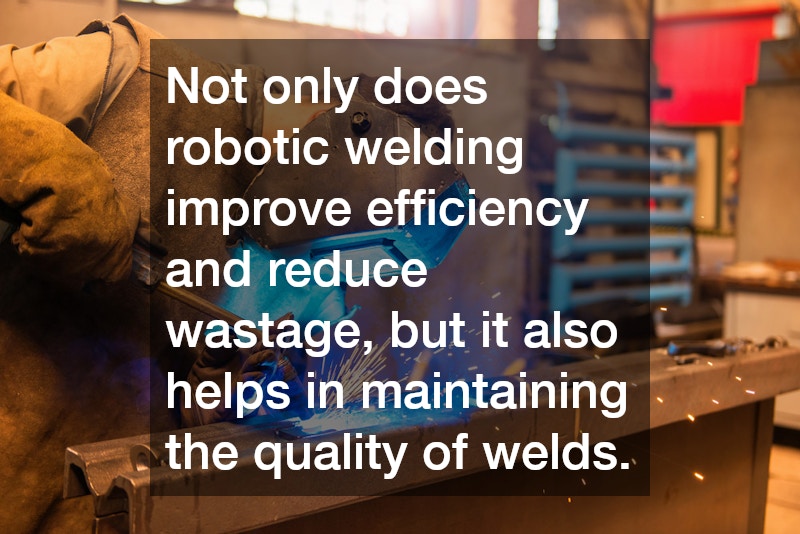Robotic welding represents a significant advancement in manufacturing technology that can offer numerous benefits to business owners. This technology involves the use of programmable robots to automate the welding process, providing greater precision and consistency. The evolution of robotic welding has been fueled by the need for increased production rates and improved quality.
As global competition intensifies, businesses are increasingly looking to incorporate robotic systems in their operations. Understanding the fundamentals of robotic welding is therefore crucial for any business owner looking to remain competitive in today’s rapidly changing market.
Not only does robotic welding improve efficiency and reduce wastage, but it also helps in maintaining the quality of welds. The precision that robotic technology can achieve reduces the likelihood of errors, leading to less rework and lower production costs. Furthermore, robots can perform tasks in environments that may be hazardous to human workers, thereby improving overall workplace safety. Investing in robotic welding can thus result in significant cost savings over time. Business owners looking to improve their manufacturing processes should seriously consider the benefits of this innovative technology.
Robotic welding can be particularly advantageous for businesses involved in mass production. This is because robots are capable of working continuously without fatigue, increasing output and ensuring timely delivery of products. Moreover, advancements in robotic technology have made these systems more accessible and affordable for small and medium-sized enterprises. For businesses aiming to scale operations or enhance their production capabilities, robotic welding presents an opportunity to achieve these goals more efficiently. As such, understanding the capability and implementation of robotic welding can be a decisive factor for growth.
Benefits of Robotic Welding for Businesses
One of the primary benefits of robotic welding is the increased efficiency it offers. When robots take over the welding process, the speed and consistency they provide can significantly boost production rates. The automated nature of robotic systems means workers can focus on other tasks, therefore optimizing the use of labor resources. This efficiency gain can be a game-changer for businesses, allowing them to meet rising demand while keeping costs under control. As a result, companies can attain a competitive edge by delivering products more quickly and reliably.
In addition to efficiency, robotic welding enhances the quality and precision of welds. The programming of robots ensures that each weld is performed with meticulous accuracy, virtually eliminating variations and defects commonly associated with manual welding. This level of precision is particularly important in industries where stringent standards are required, such as automotive and aerospace sectors. By maintaining consistently high-quality outputs, businesses can uphold their reputation and meet regulatory requirements without difficulty. Over time, the enhanced precision provided by robotic welding leads to fewer costly errors and higher overall customer satisfaction.
Moreover, integrating robotic welding into a business’s operations can lead to significant cost reductions. While the initial expense of installing robotic systems may be substantial, the long-term savings far outweigh the upfront investment. Robots offer lower operational costs due to reduced waste of materials and increased energy efficiency. They are also able to perform tasks that would otherwise require human intervention, thus reducing labor costs. These financial benefits make robotic welding an attractive option for companies looking to optimize processing costs while maintaining high production standards.
Implementing Robotic Welding in Your Business
As business owners consider the integration of robotic welding, an understanding of the initial setup and ongoing maintenance requirements is essential. The implementation process begins with a thorough analysis of the company’s current welding operations and identifying areas that would benefit most from automation. It is critical to work with experienced vendors who can provide tailored solutions that align with specific business needs. Adequate training for personnel is also vital to maximize the potential of these sophisticated machines. Ensuring a smooth transition to robotic systems can minimize downtime and enhance productivity from the onset.
Once deployed, maintaining robotic welding systems involves regular inspections and updates to keep the technology in optimal working condition. Preventative maintenance can help avoid unexpected breakdowns, further protecting business operations from disruptions. Constant technological advancements mean that business owners should be open to updating software and hardware components when necessary. Investing in ongoing employee training keeps the workforce adept at handling new features or system modifications. With a diligent approach, companies can prolong the lifespan of their robotic welding systems and capitalize fully on their investment.
Before making the shift to robotic welding, business owners should analyze the long-term return on investment such systems offer. The integration process may vary in complexity depending on the scale and scope of existing operations. An informed understanding of the financial, operational, and strategic significance of these systems ensures that they contribute positively to the business. Engaging with professional consultants for expert insights can aid in making an informed decision on adopting robotic welding. Ultimately, the ability to innovate and adapt to technological advancements will serve as a cornerstone for future success.
Incorporating robotic welding into a business’s operations offers a range of advantages that can significantly enhance productivity and competitiveness. From increased efficiency and improved precision to cost savings and heightened safety, the benefits are substantial and wide-ranging. For those willing to invest in the training and maintenance associated with these systems, the rewards can vastly exceed initial outlays. As industries continue to evolve with technology, staying ahead with robotic solutions can position businesses strongly in their respective markets. The future of manufacturing is here, and robotic welding is leading the charge with transformative potential.
However, adopting robotic welding should be a strategic decision grounded in solid analysis and planning. Business owners need to carefully assess their specific needs and capabilities before transitioning to an automated environment. The guidance of experts and partnerships with experienced vendors can be invaluable in ensuring successful implementation. With an informed approach, businesses can navigate the complexities of modernization and leverage robotic welding to secure sustained growth. Thus, understanding the intricacies and opportunities of robotic welding remains crucial for any business poised to thrive in the modern industrial landscape.
In summary, robotic welding offers enterprises the opportunity to boost operational effectiveness while maintaining high standards of quality and safety. The unique advantages provided by robotics underscore the importance of technological adoption in today’s business strategies. As global markets become more competitive, technology-driven solutions like robotic welding provide critical leverage for businesses aiming for future readiness and resilience. By embracing robotic innovations, businesses can achieve new heights in efficiency and continue to meet the demands of dynamic and evolving markets. The time for businesses to explore and invest in robotic welding is now, paving the way for enhanced growth and success.




